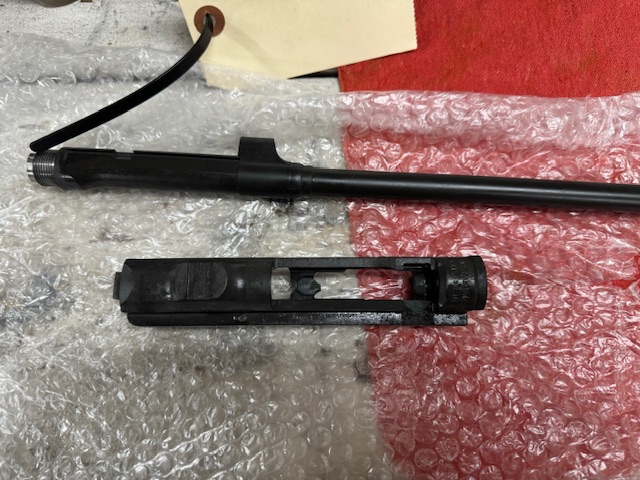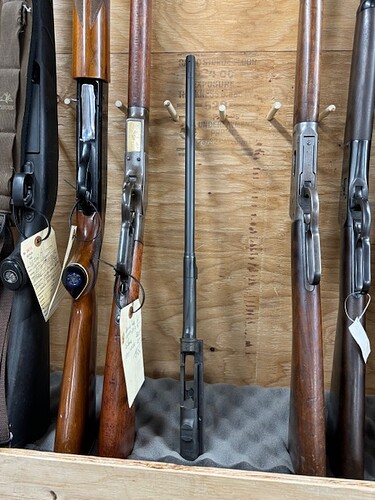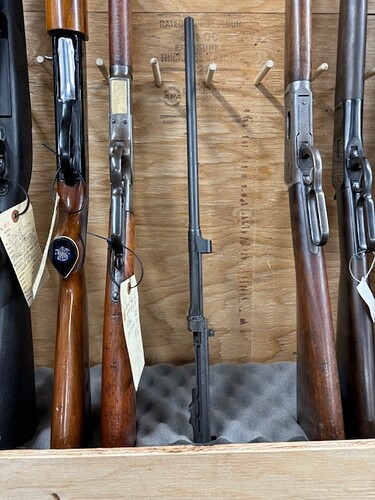Originally published at: THE .30 CARBINE – Sixguns Firearm Fraternity
TAFFIN TESTS: THE .30 CARBINE
…JOHN TAFFIN
I’ve been a long time fan of the Ruger Single Action sixgun. My first sixgun was an early Ruger Single-Six with the old-style flat loading gate. Then the big bores beckoned and it has been a long-time love affair with the Blackhawk since I bought my first .357 Flat-top in 1957 and followed it up very shortly with a .44 Magnum Flat-top. As old time cowboy, writer, and sixgunner Walter Rodgers said: “Bless Bill Ruger for putting Magnums into single-action workin’ guns.” The two Flat-tops were followed by an early Ruger Super Blackhawk, and then, wonder of wonders, Ruger chambered for the .45 Colt and I got the first one to hit Montana in ’69 or ’70. The Bisleys came along in the 1980’s in all the big bore calibers plus the diminutive .22 and .32 Magnum and they too were all welcomed with open arms. My Bisley .41 Magnum will….Well, that’s another story.
The one Ruger Blackhawk that I have totally ignored has been the .30 Carbine. Built on the Ruger Super Blackhawk sized frame, it struck me as being overly heavy, plus just who were they trying to fool? Semi-automatic cartridges don’t belong in sixguns. Do they? That is why cartridges have rims, so they can be used in sixguns. Right?
I was totally happy to go along my way and would have probably completely ignored the .30 Carbine sixgun forever. And then it happened. My shooting buddy Joe Penner called one quiet evening a few months back and said: “You’ll never guess what I just bought!” Yep, you are right, it was a .30 Carbine Blackhawk. “I just picked up a Three-Screw .30 Blackhawk for $150.” Of course he had to bring it over and I was
surprised to find a gun, even though the bluing was well worn, that locked up tight and showed no signs of abuse. Apparently everyone had passed it up because of the worn bluing and the store lowered the price until it finally sold.
”I figured you would want to try it out so I ordered a set of Lee dies with a taper crimp die plus 500 rounds of Remington brass. It will be here next week.” Then to top it off, he brought it over with a 2X Leupold scope mounted. What more could I ask for? I was ready for another break from the heavy kickers and a heavy sixgun with no recoil and a scope to help me shoot it without straining my eyes was dropped right into my lap.
Going to my storage of bullets suitable for use in the .30 Carbine, I found Speer 100 grain Plinkers and 110 grain hollow point Varminters left over from previous testing sessions with a custom .30-20 revolver. Joe brought over 500 hard cast bullets that he had
molded from Hensley & Gibb’s #250GC blocks. The 105 grain bullets were gas checked, lubed, and sized and I was ready to go to work.
The .30 M-1 Carbine is a product of World War Two and was designed to take the place of the .45 sidearm as it would be easier to fire accurately for most G.I.’s. Sometime in the 1950’s, I believe, the short lived Kimball Company produced semi-automatics chambered for the .30 Carbine round. Christy Gun Works offered .30 Carbine replacement barrels and cylinders for the Colt Single Action Army and one former soldier from the Pacific theater wrote in The American Rifleman of having a Colt Bisley converted to .30 Carbine by Christy complete with frame mounted firing pin.
But it remained for Ruger to bring out the first successful .30 Carbine handgun. They have since been joined by Thompson/Center with Contender barrels chambered in .30 Carbine, and just recently IAI has gone Kimball one better and introduced a semi-automatic .30 Carbine pistol, the AutoMag III, that really works.
It did not take me long to fall in love with the .30 Carbine Blackhawk. “Hey, Joe, wanna sell it?” The combination of light, almost non-existent, recoil with excellent accuracy, makes the .30 Blackhawk a real pleasurable sixgun to say the least.
Since the .30 Carbine is a rimless cartridge, it must headspace on the front of the case mouth in the Ruger’s cylinder. This means no crimp on the bullet which can be a problem in a revolver. In this case, recoil is not enough to cause the bullets in the remaining cases to move forward. But, a good crimp is usually necessary to get the powder burning properly. The answer to the later problem is a taper crimp die which puts a long firm pull on the bullet in the loaded brass. It is also necessary for the best accuracy.
Other than the necessity of the fourth die for utilizing the taper crimping operation, the .30 Carbine reloads as easily as the standard straight-walled sixgun cartridges. Lee offers a Carbide die set that works well except the shellholder is a somewhat sloppy fit.
The .30 Carbine is sure to be compared to the .32-20. The .32-20 has that all important rim which allows bullets to be crimped for use in sixguns, but the .30 Carbine is much
stronger brass. The necks of .32-20 brass are lost with regularity. Not so with the .30 Carbine brass. It is as tough as the other Magnum sixgun cartridges. Some have converted .30 Carbine Blackhawks to .32-20 and while it works, it does not work very well. The diameter of .32-20 is big where the .30 Carbine is little and vice-versa. What would really be a proper solution is a .30 Carbine Rimmed.
After loading 400 test rounds for the .30 Blackhawk, I prepared for some pleasant shooting. The 2X Leupold scope was easily sighted in with factory Carbine rounds. Loading the cylinder with the first batch of Speer Plinkers, I watched the first round hit dead center, then cocked the hammer for shot number two. The hammer dropped on dead
silence. Nothing. Bring the suspect cartridge back around in line. Try it again. Nothing. Again. Still would not fire. I thought this was the portent of things to come with the .30 Carbine in the Blackhawk, but it proved instead to be the one lone exception. No other malfunctions have surfaced with the Blackhawk .30 Carbine. Tainted primer perhaps.
Speer offers the two jacketed bullets that seem to be tailor-made for the .30 Carbine sixgun. One is the 100 grain plinker which is a copper cup with a lead core. No lead touches the barrel and I load these flush with the end of the copper jacket. In the past, these have not been the most accurate .30 caliber bullets when tried in other guns. They work fine in the .30 Carbine.
Some exceptional loads with the 100 grain Speer “Plinker” are 13.0 grains of AA#9 for one-inch at 25 yards and a speed over the triple skyscreens of the Oehler Model 35P of a nice round 1400 feet per second. The same accuracy is obtained with 13.5 grains of H4227 for 1331 feet per second. All loads use Federal #200 small rifle primers. Two milder loads that give even better accuracy are 15.5 grains of AA#1680 for 1136 feet per second and 7.0 grains of HS7 for 868 feet per second. The latter load seemed so mild that I tried one shot, that is all it took, without ear protection. Definitely a foolish thing to do. Even at these sedate lower muzzle velocities, the noise from the .30 Carbine can definitely be classified as earsplitting. Good hearing protection is an absolute must.
Switching over to the 110 grain Speer Varminter resulted in even greater accuracy with the .30 Carbine. Some exceptional loads are 9.0 grains of Herco (1380 feet per second), 13.5 grains of H4227 (1145 feet per second), and 14.5 grains of H4227 (1263 feet per second). These are all in the one-inch or less at 25 yards category and make explosive varmint loads. The same mild loads used with the 100 grain Plinker, 15.5 grains of AA#1680 and 7.0 grains of HS7, also result in pleasant shooting loads with the 110 grain Speer Jacketed Hollow Point.
Many sixguns shoot well with jacketed bullets; others do well with cast bullets. Happiness is finding one that does both. The Ruger .30 Carbine does both. The Hensley & Gibbs #205, 105 grain round-nosed bullet gives fast steppin’, tack-drivin’ results. Some examples are 9.0 grains of Herco (1485 fps, 1 1/4″), 12.0 grains of AA#9 (1560 fps, 3/4″), 14.5 grains of WW296 (1426 fps, 1″) 14.5 grains of H4227 (1563 fps, 5/8″), and 16.5 grains of AA#1680 (1305 fps, 3/4″). For milder loads, four to five grains of Bullseye, WW231, or WW452AA all give groups under one-inch at muzzle velocities of 850 to 1150 feet per second.
The short range silhouette Hunter/Field Pistol course was seemingly designed with the Blackhawk .30 Carbine in mind. The same cast bullet loads used for silhouetting can be used for small game shooting and varmints are well handled with either the 100 grain Plinker or 110 grain
Varminter. By no stretch of the imagination, with these loads or any others, should the .30 Carbine be considered a big game
gun. It is well below the .357 Magnum which is marginal at best for anything much larger than small deer. Keep the Carbine as it should be: for varmints, small game, plinking, and short-range silhouetting. I’m just sorry I took so long to get around to trying one. Thanks, Joe. I needed that.


